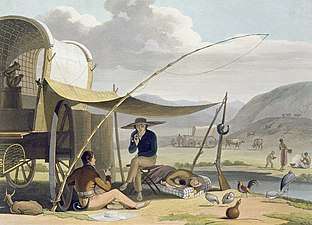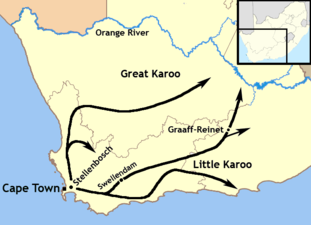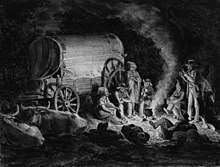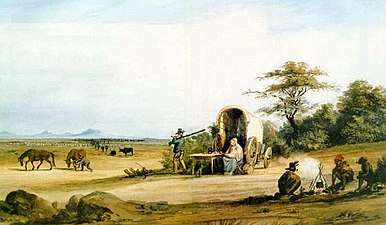Trekboer
In the history of Southern Africa, the Trekboere (now referred to as "Trekboer" in English; pronounced: /ˈtrɛkbuːr/) were nomadic pastoralists descended from European settlers on the frontiers of the Dutch Cape Colony. The Trekboere began migrating into the interior from the areas surrounding what is now Cape Town, such as Paarl (settled from 1688), Stellenbosch (founded in 1679), and Franschhoek (settled from 1688), during the late 17th century and throughout the 18th century. The Trekboer included mixed-race families of partial Khoikoi descent who had also become established within the economic class of burghers.

Origins
The Trekboere were seminomadic pastoralists, subsistence farmers who began trekking both northwards and eastwards into the interior to find better pastures/farmlands for their livestock to graze, as well as to escape the autocratic rule of the Dutch East India Company (or VOC), which administered the Cape. They believed the VOC was tainted with corruption and not concerned with the interests of the free burghers, the social class of most of the Trekboers.[1]:26
Trekboere also traded with indigenous people. This meant their herds were of hardy local stock. They formed a vital link between the pool of animals in the interior and the providers of shipping provisions at the Cape. Trekboere were nomadic, living in their wagons and rarely remaining in one location for an extended period of time. A number of Trekboere settled in the eastern Cape, where their descendants became known as Grensboere (Border Farmers).
Expansion

Despite the VOC's attempts to prevent settler expansion beyond the western Cape, the frontier of the Colony remained open: the authorities in Cape Town lacked the means to police the Colony's borders.[1]:24[2] By the 1740s the Trekboers had entered the Little Karoo. By the 1760s they reached the deep interior of the Great Karoo.[1]:24
Independent republics
Due to the collapse of the VOC (which went bankrupt in 1800) and inspired by the French Revolution (1789) and the American Revolution, groups of Boers rebelled against VOC rule. They set up independent republics in the town of Graaff-Reinet (1795), and four months later, in Swellendam (17 June 1795). A few months later, the newly established Batavian Republic nationalised the VOC (1 March 1796); the Netherlands came under the sway of the new post-revolution French government.[1]:26
The British, who occupied Cape Town in September 1795 in the course of the French Revolutionary Wars and took over the administration of Cape Colony, reversed the Trekboers' independence efforts in 1796. A generation later, another group of Boers resisted the administration of British legislation in 1815. They rebelled at Slagters Nek and the British executed some of the Boer leaders. Because of further British encroachments, constant border wars with the Xhosa to the east, and growing land shortages, numerous Boer settlers of the eastern Cape became Voortrekkers.
Legacy

Numerous Trekboere settled down to become border farmers for a few generations and later voortrekkers. But many of the group continued well into the 20th century as an economic class of nomadic pastoralists.
Many Trekboere crossed the Orange River decades before the Voortrekkers did. Voortrekkers often encountered Trekboere in Transorangia during their Great Trek of the 1830s and 1840s. In 1815, a Trekboer/trader named Coenraad (Du) Buys (a surname of French Huguenot origin) was accused of cattle theft and fled from the British. He settled in the (western) Transvaal. He allegedly contracted polygamous marriages with hundreds of indigenous women, with his descendants' populating the town of Buysplaas in the Gourits River valley. He continued having numerous wives after leaving the colony. Descendants of his second series of marriages still live in the small town of Buysville, near the mission station of Mara, 20 km to the west of Louis Trichardt in the modern Limpopo province. Buys eventually disappeared while traveling along the Limpopo River.
By the late 19th century, both the Trekboere and the Voortrekkers were collectively called Boers.
During the 20th century, both Boers and the Cape Dutch — those who did not trek eastward and remained in the Western Cape — became known as Afrikaners. This term was applied to all Afrikaans-speakers of Western and Central European (Dutch, German, French Huguenot) ancestry. The term later sometimes included Afrikaans speakers of mixed-race origins, classified as non-White (chiefly those who became known as Cape Coloureds in the Cape Province) and related mixed-race groups such as the Baster people.) Since the early 21st century, some descendants of the Trekboers have preferred to be called the boerevolk.
Language

The Trekboers spoke a variety of Dutch which they called die taal (lit. 'the language'), which evolved into the modern-day dialect Eastern Border Afrikaans, also known as East Cape Afrikaans. The Afrikaans language as a whole generally originated from 17th- and 18th-century Dutch dialects. Over time it incorporated numerous words and expressions from French, German, Portuguese, Malay, Khoi, and later also English. Still, roughly 90% of the vocabulary is of Dutch origin and it is closer linguistically to Standard Dutch than many Dutch dialects. If Afrikaans had not been defined a separate language during the 20th century, its various dialects would have been considered dialects of Dutch.[3]
See also
- Afrikaner Calvinism
- Afrikaner nationalism
- Boer
- Boer republics
- History of Cape Colony Pre-1806
References
- L'Ange, Gerald (2005). The White Africans: From Colonisation to Liberation. Cape Town: Jonathan Ball Publishers. p. 524. ISBN 1-86842-219-4.
- Giliomee, Hermann (2003). The Afrikaners: Biography of a People. Cape Town: Tafleburg Publishers Limited. pp. 31–34. ISBN 0-624-03884-X.
- Van Eeden, Petrus (1995). Afrikaans hoort by Nederlands (PDF). Retrieved 29 October 2014.